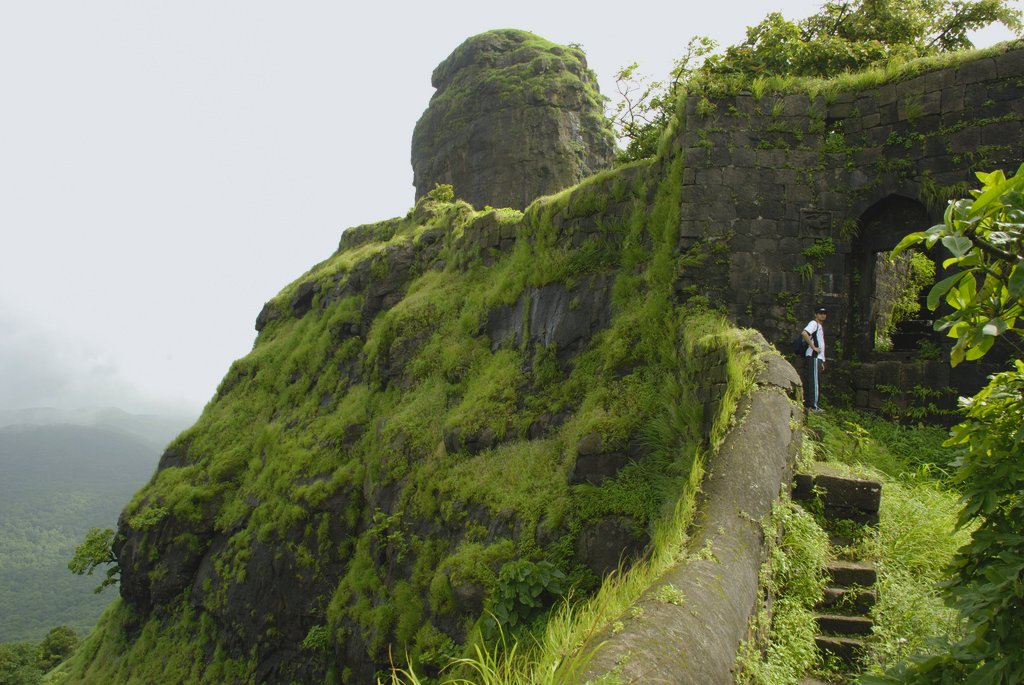Kalavantin Durg
Know about Kalavantin Durg, world's most dangerous fortress

Kalavantin Durg (Kalavantin's Fort), is located between Matheran and Panvel in the Indian state of Maharashtra, at an elevation of 2,300 feet in the Western Ghats.
It is located on a plateau very close to Matheran, but unlike Matheran Prabalgad fort does not have a good source of water supply.
It was known as Muranjan until it was taken over and renamed by the Maratha forces under Shivaji's rule.
According to legend it was built for a queen named Kalavantin but that really seems to be all that anybody knows.
The steps leading up to the fort were cut into the rock of the hill, a very impressive feat.
If this geological formation was present in many other countries it would be fenced off and no one would be allowed to climb it.
Kalvantin Durg is also called the Climb to Heaven. No rail on the edge and no ropes on the wall, God forbid if you have vertigo. Worst of all, the hardest part is coming down.
At the top of Kalavantin Durg you can see the Peb, Chanderi, Matheran, Karnala, and Ershal forts.
The city of Mumbai itself can also be seen. It is believed that the Fort was built around the time of Buddha or around or before 500 BCE.
The surrounding terrain is extremely rugged with sharp peaks. This fort was established centuries ago.
Climb stairs narrow peaks, steep slopes as challenges for visitors.
Kalavantin worthy Durg fort is considered the most dangerous in the world.

At a height of 2300 feet, Kalavantin Durg is yet another high peak in Maharashtra that beckons enthusiastic trekkers. It’s an uphill climb and takes around three and a half hours for one to scale and reach the peak. Making your way, through a road which runs a little away from the base village- Thakurwadi you begin with the snaky road that leaps and bounds and leads you to the peak.
If you are travelling from Bandra you can take the first train out to VT that leaves at 4:10 am or the one after that at around 4:30 am and get off at Vadala station. From Vadala station you can board the 5:09 am train that leaves for Panvel and reaches at 6:10 am. Once at Panvel, it’s a brisk eight minute walk to the bus depot. Ask around and you can take a bus to the village Thakurwadi, the first bus leaves around half five, followed by another at 7am. While waiting for the bus, you could munch on a quick snack or sip from garam chai and gear up for the long-drawn-out road ahead. The next bus is around 9:40 am, but its best to take the 7am bus and begin your trek early. It’s an hour’s drive to the base village from where you can begin your uphill climb. Its best to take a bus as the fare is INR 18/- only as compared to a local auto where the fare is INR 300/- which can seat four passengers only.

From the base of the village you can spot the two ranges that are spread ahead of you. Prabalgad is one of the peaks and other is Kalavantin Durg. Ask the enthusiastic villagers for direction to the respective peak and they will happily guide you. If you do have a keen and watchful eye for nature you will spot the many bird species, plant varieties and insects that dwell in the lush greenery.
Once you have trekked for around two hours, you will see a deity carved into a rock and coated with a spray of orange. A little further on and you are in for a treat at a small shack which provides not only chai but also dishes out meals and makes available stay and lodging. You can contact either Namdev K. Bhutanbra on 08451929898 or Balu on 08097089491 or Nilesh on 08056186321 and book your stay if you want to spend your night in the lap of nature and enjoy the breathtaking view all around you. They also have their own website and well written blog that you can research for more details. (website: prabalgad.jigsy.com or Blog: prabalgad.blogspot.com)
The best time to trek is around June to Jan. One can trek during the monsoons and enjoy the sudden burst of showers or during the cool winters and experience the blowy winds. Although trekking during the monsoon is a bit risky as the path all along has patches of loose mud and rolling stones. Stop along the way at the many streams and baby waterfalls and splash on some chilly water to freshen up or just take a quick dip and laze around in the flowing waters for a while.
As you continue your walk through the muddy and rocky path, you will begin to see more of Kalavantin Durg which makes it seem you have lots more to accomplish. But another hour and a half and you are ascending the never ending flight of stairs.
The zigzag flight of stairs that are cut into the hill are also laden with moss, which make the climb risky and knotty. You need to ensure your hands are free and you have something to hold on too while ascending the peak. Once you have ascended the peak its sheer pride and happiness and a moment of triumph.
A trek certainly not for amateurs but for those to like to make their way along the treks least treaded upon. There are also buses that ply along and leave from Thakurwadi to Panvel at 5, 6, 7 and 8pm.
Happy trekking!




















